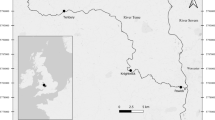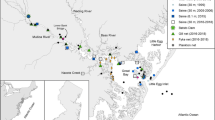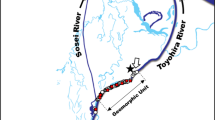Abstract
The morphologically unique and endangered humpback chub, Gila cypha, is found in canyon-bound reaches of the Colorado River and its tributaries. Now limited to six isolated reproducing populations, this species is believed to have been once distributed over a large portion of the mainstem river. Because the species inhabits remote canyon areas, little is known about its spawning ecology. The largest remaining population occurs in the lower Little Colorado River (LCR) near Grand Canyon, where we conducted a three-year study of spawning ecology during spring (March-June) 1993–1995. We analyzed seasonal patterns of movement, population density, relative condition, spawning scores, and frequency of ripe condition and fin abrasions and compared these data with seasonal discharge and water temperature to determine spawning phenology and ecology. Spawning commenced in late March, peaked in mid-April, and waned in mid-May. A high proportion of males remained ripe over this period, whereas ripe females were relatively abundant only in April. Increased densities of adult fish in March-April and rapid declines in May-June coupled with recaptures of 18.4% of these adults in the Colorado River suggest that a portion of the population migrated from the Colorado River into the LCR to spawn and then returned. Ripe males aggregated in areas of complex habitat structure with high angular variation in bottom profiles (matrix of large boulders, travertine masses combined with chutes, runs and eddies, 0.5–2.0 m deep) and were associated with deposits of clean gravel. Ripe females appeared to move to these male aggregations to spawn. Near-spawning (including gravid) females and non-spawning fish used similar habitats and were segregated but close (< 50 m) to habitats occupied by aggregations of ripe males. Abrasions on anal and lower caudal fins of males and females suggest that spawning involves contact with gravel substrates, where semi-adhesive eggs are deposited and fertilized. The findings of this study should aid recovery efforts for humpback chub by identifying spawning habitat within the historic distributional range where additional spawning stocks could be established.
Similar content being viewed by others
References cited
Cole, G.A. 1975. Calcite saturation in Arizona waters. Verhandl. internat. Vereinigung theoret. angewandte Limnol. 19: 1675-1685.
Cooley, M.E. 1976. Spring flow from near-Pennsylvanian rocks in the southwestern part of the Navajo Indian Reservation, Arizona. U.S. Geol. Surv. Prof. Paper 521-F, U.S. Gov. Printing Office, Washington, D.C. 15 pp.
Douglas, M.E. & P.C. Marsh. 1996. Population estimates/population movements of Gila cypha, an endangered cyprinid fish in the Grand Canyon region of Arizona. Copeia 1996: 15-28.
Gary, M., R. McAfee Jr. & C.L. Wolf. (ed.) 1972. Glossary of geology. American Geological Institute, Washington, D.C. 805 pp.
Gorman, O.T. 1988. The dynamics of habitat use in a guild of Ozark minnows. Ecol. Monogr. 58: 1-18.
Gorman, O.T. & J.R. Karr. 1978. Habitat structure and stream fish communities. Ecology 59: 507-515.
Hamman, R.L. 1982. Spawning and culture of humpback chub. Prog. Fish-Cult. 44: 213-216.
Johnston, C.E. 1999. The relationship of spawning mode to conservation of North American minnow (Cyprinidae). Env. Biol. Fish. 55: 21-30 (this issue).
Johnston, C.E. & L.M. Page. 1993. The evolution of complex reproductive strategies in North American minnows (Cyprinidae), pp. 600-621. In: R.L. Mayden (ed.) Systematics, Historical Ecology, and North American Freshwater Fishes, Stanford University Press, Stanford.
Kaeding, L.R. & M.A. Zimmerman. 1983. Life history and ecology of the humpback chub in the Little Colorado and Colorado rivers of the Grand Canyon. Trans. Amer. Fish. Soc. 112: 577-594.
Kaeding, L.R., B.D. Burdick, P.A. Schrader & C.W. McAda. 1990. Temporal and spatial relations between the spawning of humpback chub and roundtail chub in the upper Colorado River. Trans. Amer. Fish. Soc. 119: 135-144.
Karp, C.A. & H.M. Tyus. 1990. Humpback chub (Gila cypha) in the Yampa and Green rivers. Dinosaur National Monument, with observations on roundtail chub (Gila robusta) and other sympatric fishes. Great Basin Nat. 50: 257-264.
LeCren, E.D. 1951. The length-weight relationship and seasonal cycle in gonad weight and condition in the perch Perca fluviatilis. J. Anim. Ecol. 20: 201-219.
Marsh, P.C. 1985. Effect of incubation temperature on survival of embryos of native Colorado River fishes. Southwest. Nat. 30: 129-140.
Miller, R.R. 1946. Gila cypha, a remarkable new species of cypri nid fish from the Colorado River in Grand Canyon, Arizona. J. Wash. Acad. Sci. 36: 409-415.
Rakes, P.L., J.R. Shute & P.W. Shute. 1999. Reproductive behavior, captive breeding, and restoration ecology of endangered fishes. Env. Biol. Fish. 55: 31-42 (this issue).
Suttkus, R.D. & G.H. Clemmer. 1977. The humpback chub, Gila cypha, in the Grand Canyon area of the Colorado River. Occas. Papers Tulane Univ. Mus. Nat. Histor. 1: 1-30.
Valdez, R.A. & G.H. Clemmer. 1982. Life history and prospects for the recovery of the humpback and bonytail chub. pp. 109-119. In: W.H. Miller, H.M. Tyus & C.A. Carlson (ed.) Fishes of the upper Colorado River System: Present and Future. Western Division, American Fisheries Society, Bethesda.
Valdez, R.A. & B.C. Nilson. 1982. Radiotelemetry as a means of assessing movement and habitat selection of humpback chub. Trans. Bonneville Chapt. Amer. Fish. Soc. 182: 29-39.
Author information
Authors and Affiliations
Rights and permissions
About this article
Cite this article
Gorman, O.T., Stone, D.M. Ecology of spawning humpback chub, Gila cypha, in the Little Colorado River near Grand Canyon, Arizona. Environmental Biology of Fishes 55, 115–133 (1999). https://doi.org/10.1023/A:1007450826743
Issue Date:
DOI: https://doi.org/10.1023/A:1007450826743




